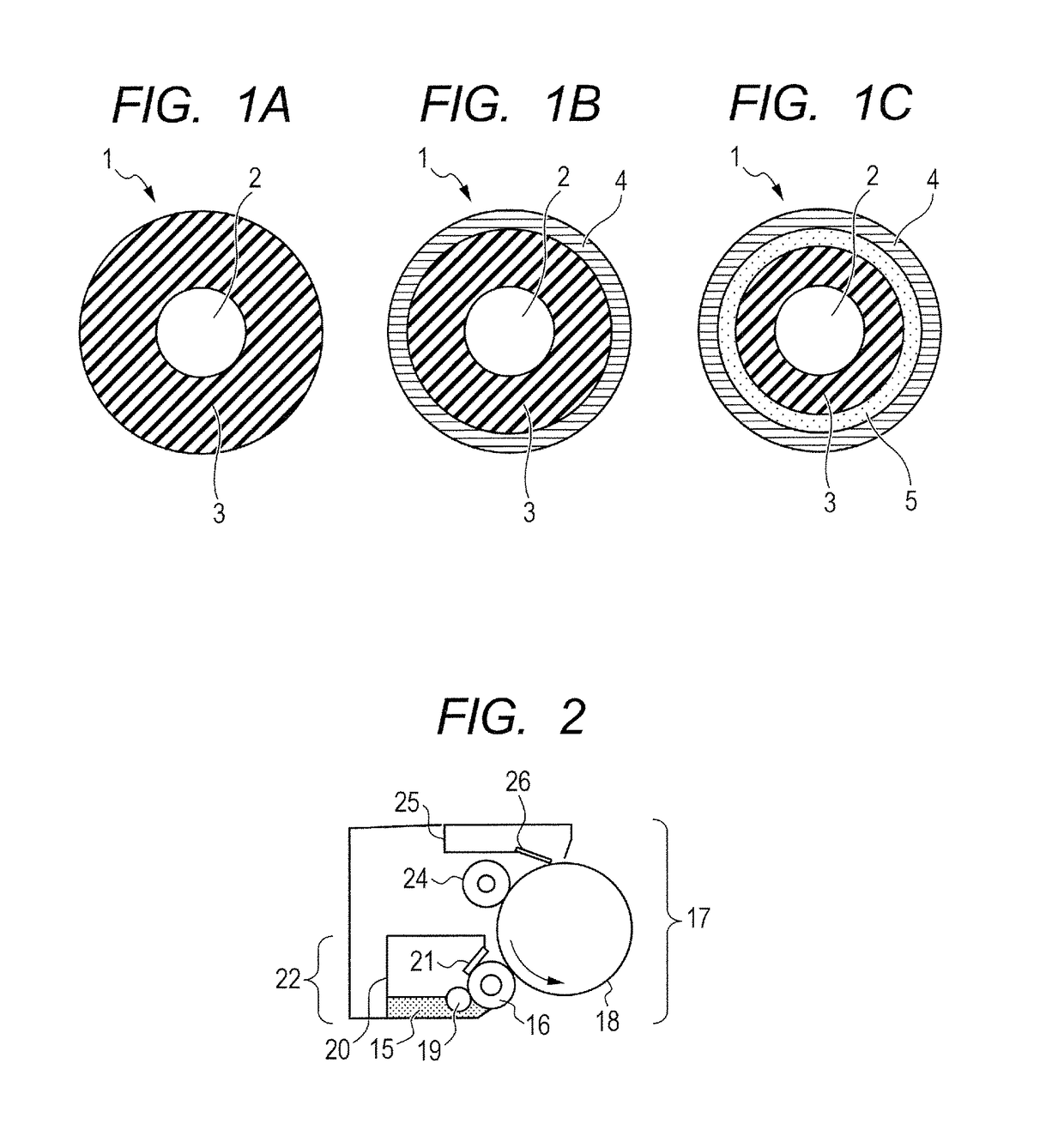Electrophotographic member, process cartridge, and electrophotographic apparatus
a technology of electrophotography and process cartridges, applied in the direction of electrographic process apparatus, instruments, corona discharge, etc., can solve the problems of reducing the quality of electrophotographic images, unable to readily prevent the generation of local low resistance portions, and difficult homogeneous dispersal of electro-conductive particles such as carbon black, so as to achieve high-quality electrophotographic images and reduce the bleeding out of an ion conducting agent.
- Summary
- Abstract
- Description
- Claims
- Application Information
AI Technical Summary
Benefits of technology
Problems solved by technology
Method used
Image
Examples
example 1
[0178]The method of producing the electrophotographic member according to the present invention will now be described.
[0179]The following materials were mixed by stirring to prepare a material for a surface layer.[0180]reactive compound[0181]Isocyanate group-terminated prepolymer B-1 66.4 parts by mass[0182]polyol[0183]Polyol E-1 (poly(tetramethylene glycol) (available from Mitsubishi Chemical Corporation)) 30.6 parts by mass[0184]ion conducting agent[0185]Ion conducting agent C-1 3.0 parts by mass[0186]urethane resin fine particles (trade name, Art-pearl C-400; available from Negami Chemical Industrial Co., Ltd.) 90.0 parts by mass
[0187]Next, methyl ethyl ketone (hereinafter, referred to as MEK) was added to the mixture such that the total solid content was 30% by mass, and was mixed with a sand mill. The viscosity of the mixture was adjusted with MEK to 10 to 13 cps to prepare a coating material for forming a surface layer.
[0188]Elastic roller D-1 prepared above was immersed in th...
example 8
[0206]A method of producing another electrophotographic member according to the present invention will now be described.
[0207]The following materials were mixed by stirring to prepare a material for a surface layer.[0208]reactive compound[0209]Reactive compound R-2 (bisphenol A diglycidyl ether (available from Tokyo Chemical Industry Co., Ltd.)) 18.0 parts by mass[0210]polyol[0211]Polyol E-4 (polyethylene glycol (available from Sanyo Chemical Industries, Ltd.)) 72.0 parts by mass[0212]ion conducting agent[0213]Ion conducting agent C-8 10.0 parts by mass[0214]urethane resin fine particles (trade name, Art-pearl C-400; available from Negami Chemical Industrial Co., Ltd.) 90.0 parts by mass
[0215]Next, methyl ethyl ketone (hereinafter, referred to as MEK) was added to the mixture such that the total solid content was 30% by mass, and was mixed with a sand mill. The viscosity of the mixture was adjusted with MEK to 10 to 13 cps to prepare a coating material for forming a surface layer.
[0...
example 9
[0217]A method of producing another electrophotographic member according to the present invention will now be described.
[0218]The following materials were mixed by stirring to prepare a material for a surface layer.[0219]reactive compound[0220]Reactive compound R-3 (2,4,6-tris[bis(methoxy methyl)amino]-1,3,5-triazine (available from Tokyo Chemical Industry Co., Ltd.)) 15.0 parts by mass[0221]polyol[0222]Polyol E-4 (polyethylene glycol (available from Sanyo Chemical Industries, Ltd.)) 82.0 parts by mass[0223]ion conducting agent[0224]Ion conducting agent C-9 3.0 parts by mass[0225]urethane resin fine particles (trade name, Art-pearl C-400; available from Negami Chemical Industrial Co., Ltd.) 90.0 parts by mass
[0226]Next, methyl ethyl ketone (hereinafter, referred to as MEK) was added to the mixture such that the total solid content was 30% by mass, and was mixed with a sand mill. The viscosity of the mixture was adjusted with MEK to 10 to 13 cps to prepare a coating material for form...
PUM
 Login to View More
Login to View More Abstract
Description
Claims
Application Information
 Login to View More
Login to View More - R&D
- Intellectual Property
- Life Sciences
- Materials
- Tech Scout
- Unparalleled Data Quality
- Higher Quality Content
- 60% Fewer Hallucinations
Browse by: Latest US Patents, China's latest patents, Technical Efficacy Thesaurus, Application Domain, Technology Topic, Popular Technical Reports.
© 2025 PatSnap. All rights reserved.Legal|Privacy policy|Modern Slavery Act Transparency Statement|Sitemap|About US| Contact US: help@patsnap.com



